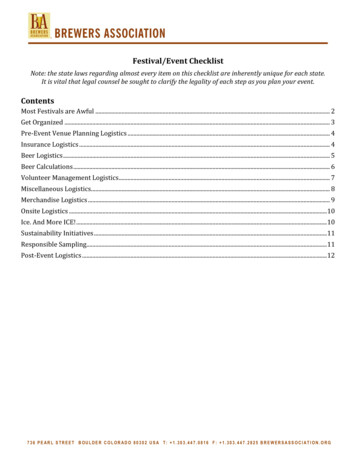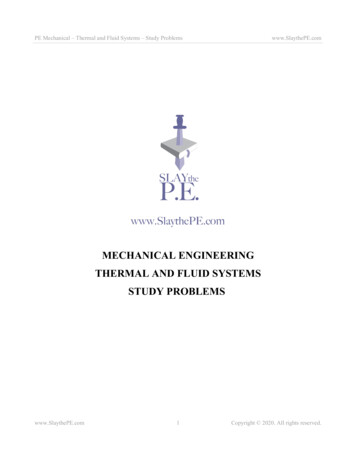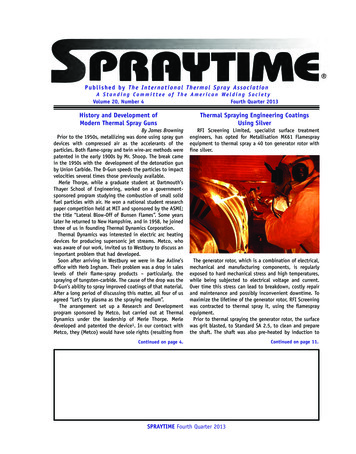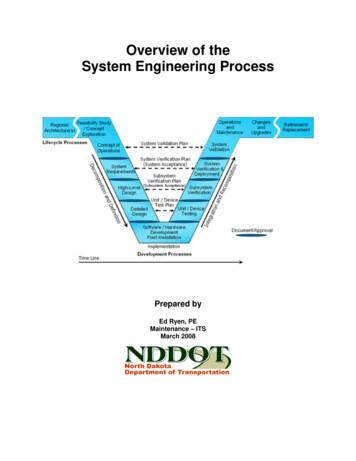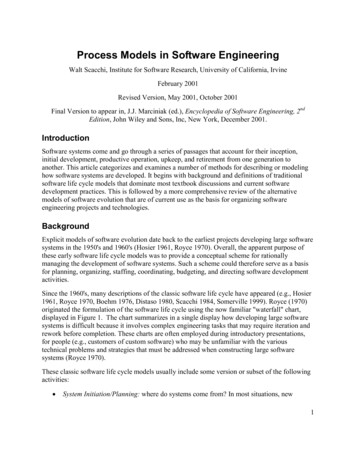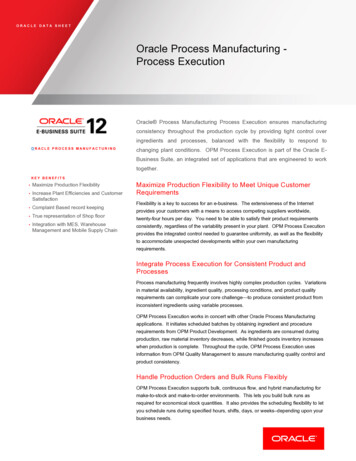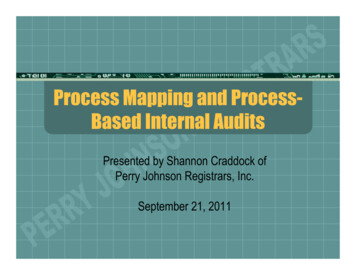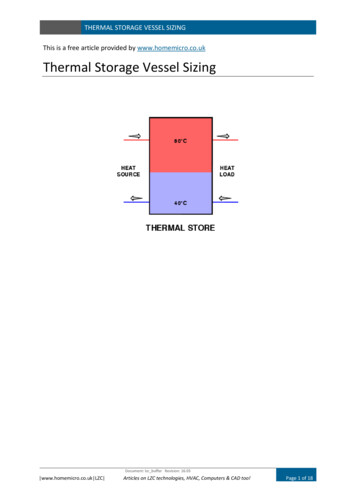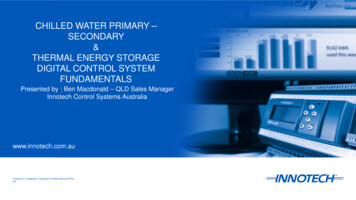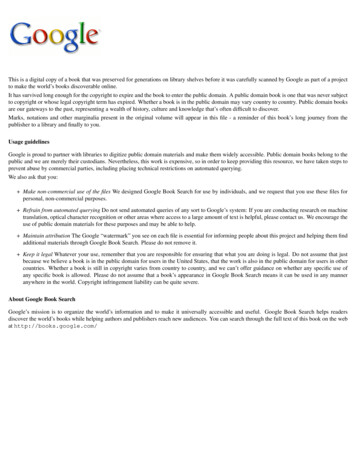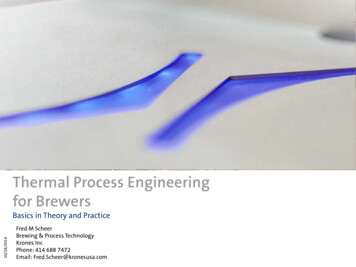
Transcription
Thermal Process Engineeringfor Brewers10/24/2014Basics in Theory and PracticeFred M ScheerBrewing & Process TechnologyKrones IncPhone: 414 688 7472Email: Fred.Scheer@kronesusa.com
2 kronesThermal ProcessEngineering for BrewersBeispieltextTable of Content Why is a Basic Knowledge important for Brewers? Necessary Basics of Thermodynamics Heat and EnergyDefinition of Thermodynamic ParametersThermal Energy and PowerHeat TransferHow can Brewers improve the k-value and theHeat Transfer? Practical Calculations in the Brewery10/24/2014 MashingWort BoilingWort Cooling with a Plate Heat ExchangerImportance of Tank InsulationFermentation Final Remarks
3 kronesThermal ProcessEngineering for BrewersBeispieltextWhy is a Basic Knowledge important for Brewers? Heat exchange can be found everywhere in the brewery!Heating up the mash and hold thetemperature break10/24/2014Wort boiling
4 kronesThermal ProcessEngineering for BrewersBeispieltextWhy is a Basic Knowledge important for Brewers? Heat exchange can be found everywhere in the brewery!10/24/2014Wort coolingHeat transfer between a tank and itsenvironment (for instance brewing liquor)
5 kronesThermal ProcessEngineering for BrewersBeispieltextWhy is a Basic Knowledge important for Brewers? Heat exchange can be found everywhere in the brewery!Fermentation and beer storage10/24/2014Flash pasteurization
6 kronesThermal ProcessEngineering for BrewersBeispieltextWhy is a Basic Knowledge important for Brewers? Average heat/cooling consumption of a 83,000 bbl brewery (100,000 hl)Heat consumption of thebrewhouse:Of that mashing (infusion):3 kWh/bbl sales beerOf that boiling (10% totalevaporation):13.5 kWh/bbl sales beerHeat consumption of the wholebrewery:44.1 kWh/bbl sales beerCooling consumption of the wholebrewery:10/24/201422.5 kWh/bbl sales beer7.7 kWh/bbl sales beer 50% of the totalheat are consumedin the brewhouse!
7 kronesThermal ProcessEngineering for BrewersBeispieltextWhy is a Basic Knowledge important for Brewers? Heating oil price development in the past10/24/2014 The price for heating oil rose in the past and will be unstable in the future!
8 kronesThermal ProcessEngineering for BrewersBeispieltext10/24/2014Why is a Basic Knowledge important for Brewers? Heat transfer is part of many processesduring beer production. The knowledge about the physics behind isimportant to ensure high product quality. It also offers the opportunity to improve yourwort-/beer taste. Understandingheattransfermeansrecognizing potential to save money in thefuture. Saving primary energy means to be moreindependent of the uncertain developmentof heating oil prices. Additionally,decreased.CO2-Emissionmaybe
9 kronesThermal ProcessEngineering for BrewersBeispieltextTable of Content Why is a Basic Knowledge important for Brewers? Necessary Basics of Thermodynamics Heat and EnergyDefinition of Thermodynamic ParametersThermal Energy and PowerHeat TransferHow can Brewers improve the k-value and theHeat Transfer? Practical Calculations in the Brewery10/24/2014 MashingWort BoilingWort Cooling with a Plate Heat ExchangerImportance of Tank InsulationFermentation Final Remarks
10 ThermalBeispieltextProcess Engineering for BrewerskronesHeat and Energy What is heat?Heat (abbreviation 𝑸 ) is energy that is being transferred based on a temperature differenceof a system and its environment (or between two systems) across the common systemboarder.Heat comes from the higher temperature level to the lowertemperature level. The results are often serious.10/24/2014 Therefore, heat always flows from the system with a higher temperature level to thesystem with lower temperature level (according to the second law of thermodynamics). Heat flow (𝑸̇ )is determined as the transferred heat in a certain time interval. It can beconsidered the same as the thermal power.
11 ThermalBeispieltextProcess Engineering for BrewerskronesHeat and Energy Heat is transferred energy. But how is energy defined? Example: What contains more energy: a cup of hot soup or a glass of water? Obviously, the soup has got more energy because of its higher temperature.10/24/2014 Energy is the ability of a system to work or to release heat.
12 ThermalBeispieltextProcess Engineering for BrewerskronesDefinition of Thermodynamic Parameters Specific heat capacity 𝑐𝑝 (also called specific heat): The specific capacity describes which quantity of heat is required to rise the temperature𝑘𝑘of 1 kg of a certain substance by 1 Kelvin. The physical unit is. The 𝑐𝑝 value only𝑘𝑘 𝐾applies for a certain pressure.FluidWater𝑘𝑘] for atmospheric pressure𝑘𝑘 𝐾3.73Mash (20 P)3.60Mash (25 P)3.46AirSpecific heat value4.18Mash (15 P)Wort10/24/2014𝑐𝑝 [4.0 – 4.11.005 With increasing density of the mashes, the specific heat decreases.
13 ThermalBeispieltextProcess Engineering for BrewerskronesDefinition of Thermodynamic Parameters Specific Enthalpy ℎ: Enthalpy means the content of heat of a body. The specific enthalpy is the heat in𝑘𝑘𝑘𝑘relation to mass [ ]. For fluids applies:ℎ 𝑐𝑝 Δ𝑇𝑇: Temperatureenthalpy specific heat value X delta Temperature Enthalpy of vaporization/-condensation 𝑟 [𝑘𝑘𝑘𝑘] is the content of heat that isrequired/released for changing the state of aggregation from liquid to vapor state andvice versa. The amount of enthalpy depends on the pressure level of the system (vaporpressure!). For condensing saturated steam applies:Pressure of the system(abs.)10/24/20141.0ℎ 𝑟𝑘𝑘𝑟 [𝑘𝑘] for water/vapor 4
14 ThermalBeispieltextProcess Engineering for BrewerskronesThermal Energy and Power How can you calculate the energy of a fluid?Generally:For fluids:Saturated steam:Specific Enthalpy ℎ𝑄 𝑚 ℎ𝑄 𝑚 𝑐𝑝 Δ𝑇𝑄 𝑚 𝑟𝑚: Mass ofthe materialSpecific heatcapacity 𝑐𝑝Enthalpy of vaporization/-condensation 𝑟 The required thermal power can be found by considering the time to heat up a body/fluid:𝑄̇ 𝑄𝑡10/24/2014Further examples concerning brewing in a later chapter𝑡: Time
15 ThermalBeispieltextProcess Engineering for BrewerskronesHeat Transfer 3 possibilities of transferring heat through avessel wall: Heat conduction Convection Heat radiation (not considered in thispresentation, but in fact has influence onwort boiling and cooling outdoorfermentation tanks)10/24/2014 In reality, there is always a combination ofthe three types.
10/24/201416 ThermalBeispieltextProcess Engineering for Brewerskrones
17 ThermalBeispieltextProcess Engineering for BrewerskronesHeat Transfer Heat conduction and thermal conductivity λ(„lambda“ ): Material property that describes how bigthe temperature difference between thein- and outside of a wall is.𝐴𝑄̇ λ (𝑇𝑊𝑊 𝑇𝑊𝑊 )𝑠Material10/24/2014Stainless Steelλ[𝑾] for 68 F𝒎 Temperature levelwall 1 𝑇𝑊𝑊Thermalp[ower SteamHeat transferarea 𝐴Temperature levelwall 2 𝑇𝑊𝑊Wallthickness 𝑠
18 ThermalBeispieltextProcess Engineering for BrewerskronesHeat Transfer Convection 10/24/2014 SteamWallThe convection coefficient 𝜶 describes theability of a fluid (gas) to gather / releaseenergy from / to the surface of a wall.𝑄̇ α1 𝐴 (𝑇1 𝑇𝑊1 )𝑊α (unit) can be specified by𝑚2 𝐾experiments using dimensionless numbers(e.g. Reynold’s number).α-value depends on: Material properties (of the wall and ofthe fluid) Fluid flow near the wall (higherturbulents result in better α)Steam temperature 𝑇1Temperature levelwall 1 𝑇𝑊𝑊Heat transferarea 𝐴α1Wallthickness 𝑠
19 ThermalBeispieltextProcess Engineering for BrewerskronesHeat Transfer The real heat transfer:Steam In real heating (and cooling!) processes, acombination of conductivity andconvection takes place. The whole heat transfer is characterizedby the k-value. 𝑘 1α1 1𝑠λ1 α2𝑄̇ 𝑘 𝐴 (𝑇1 𝑇2 )Temperature gradient:The driving force of heatHeat transfertransferConventional mash tuns obtain a k-value𝑊of 1,000 – 1,500 2𝑚 𝐾10/24/2014Steamtemp. 𝑇1 The k-value is a dimension that estimateswhether much or less heat is transferredarea �2Wallthickness 𝑠Mash temp. 𝑇2
20 ThermalBeispieltextProcess Engineering for BrewerskronesHow can Brewers improve the k-value and the Heat Transfer? Basically, the higher the turbulences in theproduct and the heating medium, the better thek-value Possibilities for higher turbulences: Proper agitation during mashing, including afitting agitator shape (propeller mixer) Special surface of the mash tun/kettle Pillow Plates, increasing the heat𝑊exchange area (k-value: 2,000 2 )10/24/2014 𝑚 𝐾Using a circulation pump during boiling. Avoid fouling and calcification! Correct andproper cleaning of the tanks is important! Shape of the heating/cooling pipes. Improved shape of the heat exchanger platesof the wort cooler or flash pasteurizer.Flow profileof an evensurfaceFlow profileof astructuredsurface
21 ThermalBeispieltextProcess Engineering for BrewerskronesTable of Content Why is a Basic Knowledge important for Brewers? Necessary Basics of Thermodynamics Heat and EnergyDefinition of Thermodynamic ParametersThermal Energy and PowerHeat TransferHow can Brewers improve the k-value and theHeat Transfer? Practical Calculations in the Brewery10/24/2014 MashingWort BoilingWort Cooling with a Plate Heat ExchangerImportance of Tank InsulationFermentation Final Remarks
22 ThermalBeispieltextProcess Engineering for BrewerskronesMashing Assumptions 10/24/2014 Mash volume 𝑉:58 hl or 5,800 lHeat capacity of the mash 𝑐𝑝 :3.6Transfer mash temperature 𝑇𝑜𝑜𝑜 :351 K (172 F)Heating rate 𝐻𝐻:1 K/minDensity of the mash ρ𝑀 :Mash-in temperature 𝑇𝑖𝑖 :Heat transfer losses 𝑓𝑙𝑙𝑙𝑙 :1.06 kg/l𝑘𝑘𝑘𝑘 𝐾333 K (140 F)5%Can be decreased byimproving the k-value!
23 ThermalBeispieltextProcess Engineering for BrewerskronesMashing Which amount of heat is required?𝑄 𝑚 ℎ𝑄 𝑚 𝑐𝑝 Δ𝑇 General equation: Considering mash: Considering 𝑚 ρ 𝑉𝑄 ρ𝑀 𝑉 𝑐𝑝 (𝑇𝑜𝑜𝑜 𝑇𝑖𝑖 ) Considering 𝑓𝑙𝑙𝑙𝑙𝑄 ρ𝑀 𝑉 𝑐𝑝 (𝑇𝑜𝑜𝑜 𝑇𝑖𝑖 ) 𝑓𝑙𝑙𝑙𝑙𝑄 ρ𝑀 𝑉 𝑐𝑝 𝑇𝑜𝑜𝑜 𝑇𝑖𝑖 𝑓𝑙𝑙𝑙𝑙 1.06Density of mashHeat capacity of mash𝑘𝑘𝑙 5,800 𝑙 3.6418,310 𝑘𝑘 116.2 𝑘𝑘𝑘𝑘𝑘𝑘𝑘 𝐾 351 𝐾 333 𝐾 1.05 Heat capacity of mashVolume of mash10/24/2014 This calculation applies for every infusion-mashing. For more precise calculation, youneed to know your exact material data and you have to find out you transfer losses
24 ThermalBeispieltextProcess Engineering for BrewerskronesMashing What amount of steam do you need to heat up the mash? The heat required from the mash must be served by the steam. Assumingwe work with a saturated steam over pressure of 1 bar (equals 14.5 psi):𝑄𝑚𝑚𝑚𝑚 𝑄𝑠𝑠𝑠𝑠𝑠𝑄𝑚𝑚𝑚𝑚 𝑚𝑠𝑠𝑠𝑠𝑠 𝑟1 𝑏𝑏𝑏𝑚𝑠𝑠𝑠𝑠𝑠 𝑄𝑚𝑚𝑚𝑚𝑟1 𝑏𝑏𝑏 418,310 𝑘𝑘2,206.1 𝑘𝑘/𝑘𝑘Enthalpy ofcondensation2,206.1 kJ/kg 189.6 𝑘𝑘 steam The consideration for the thermal power during heating-up from one rest to another areanalog.10/24/2014Heating ratedetermines thethermal power(and vice versa)Density ofmashHeat flowMass flow ofsaturated steam𝑄̇𝑚𝑚𝑚𝑚 𝑄̇𝑠𝑠𝑠𝑠𝑠ρ𝑀 𝑉 𝑐𝑝 𝐻𝐻 𝑚̇𝑠𝑠𝑠𝑠𝑠 𝑟1 𝑏𝑏𝑏𝑘𝑘𝑘𝑘𝐾𝑘𝑘1.06 5,800 𝑙 3.6 1 𝑚̇𝑠𝑠𝑠𝑠𝑠 2,206.1𝑙𝑘𝑘 𝐾 60𝑠𝑘𝑘369 𝑘𝑘𝑘𝑘𝑘𝑘𝑚̇𝑠𝑠𝑠𝑠𝑠 0.167 102,206.1 𝑘𝑘/𝑘𝑘𝑠𝑚𝑚𝑚Specific heatcapacity
25 ThermalBeispieltextProcess Engineering for BrewerskronesWort Boiling Example: External boiling: How often must the wort circulate to achievethe desired evaporation? Assumptions 10/24/2014 The technology ensures an evaporation rate 𝐸 of 6%/hDensity water ρ𝑊𝑊𝑊𝑊𝑊 :Density wort ρ𝑊𝑜𝑜𝑜 :Specific heat 𝑐𝑝,𝑊𝑊𝑊𝑊 :965 kg/m31,030 kg/m34.1𝑘𝑘𝑘𝑘 𝐾Density of wort at boiling-temperature. Withincreasing temperature, the density decreases. Boiling-temperature means lower densityTemperature difference Δ𝑇 between in- and outlet of the boiler: 5 KEnthalpy of evaporation 𝑟: 2,250 kJ/kg
26 ThermalBeispieltextProcess Engineering for BrewerskronesWort Boiling Example: External boiling: How often must the wort circulate to achieve thedesired evaporation? The number of cycles is defined by the wort flow and the cast out wort𝑉̇𝑤𝑤𝑤𝑤𝑛 𝑉𝑐𝑐𝑐𝑐 𝑜𝑜𝑜 The thermal power of boiling power must be the same as the thermal powerfor evaporation.Density wortHeat capacityHeat flowMust bethe same!10/24/2014 Result:̇𝑄̇𝑏𝑏𝑏𝑏𝑏𝑏 𝑉𝑤𝑤𝑤𝑤 ρ𝑊𝑊𝑊𝑊 𝑐𝑝,𝑊𝑊𝑊𝑊 ��𝑒 𝑉𝑐𝑐𝑐𝑐 𝑜𝑜𝑜 𝐸 ρ𝑊𝑊𝑊𝑊𝑊 𝑟The evaporation rate always refersto the cast out wortEnthalpy of condenstionDensitywater𝑘𝑘10.06 965 3 2,250 𝑘𝑘/𝑘𝑘𝐸 ρ𝑊𝑊𝑊𝑊𝑊 𝑟1𝑚ℎ𝑛 6.2𝑘𝑘𝑘𝑘ρ𝑊𝑊𝑊𝑊 𝑐𝑝,𝑊𝑊𝑊𝑊 Δ𝑇ℎ 5𝐾1,030 3 4.1𝑚𝑘𝑘 𝐾 7 cycles per hour required!
27 ThermalBeispieltextProcess Engineering for BrewerskronesWort Cooling While cooling down the wort, hot brewing liquor will be gained. For the configuration of a counter-flow plate exchanger, one has toconsider the different temperatures of the water in different parts of thewort cooler.Temperature366 KInlet temperature of the wortΔ𝑇𝑚𝑚𝑚Outlet temperature of the wort344 K288.5 KOutlet temperature of thebrewing liquorΔ𝑇𝑙𝑙𝑙275 KInlet temperature of the brewing liquorExchange area For that purpose, the average logarithmic temperature Δ𝑇𝑙𝑙𝑙 is used for calculations:10/24/2014Δ𝑇𝑚𝑚𝑚 Δ𝑇𝑙𝑙𝑙Δ𝑇𝑙𝑙𝑙 Δ𝑇ln( Δ𝑇𝑚𝑚𝑚 )𝑙𝑙𝑙
28 ThermalBeispieltextProcess Engineering for BrewerskronesWort Cooling Assumptions: The wort gets chilled down from 200 to 60 F (equals 366 to 288.5 K) The brewing liquor’s temperature rises from 36 to 165 F (275 to 344 K) Δ𝑇ℎ𝑖𝑖𝑖 366 𝐾 344 𝐾 22 𝐾 Δ𝑇𝑙𝑙𝑙 288.5 𝐾 275 𝐾 13.5 𝐾 ln(Δ𝑇ℎ𝑖𝑖𝑖Δ𝑇𝑙𝑙𝑙) 22 𝐾 13.5 𝐾ln(22 𝐾)13.5 𝐾 17.4 𝐾Required thermal power:ρ𝑤𝑤𝑤𝑤 𝑉𝑐𝑐𝑐𝑐 𝑜𝑜𝑜 𝑐𝑝,𝑤𝑤𝑤𝑤 (𝑇𝑤𝑤𝑤𝑤,𝑖𝑖𝑖𝑖𝑖 𝑇𝑤𝑤𝑤𝑤,𝑜𝑜𝑜𝑜𝑜𝑜 )Density wort𝑄̇ Heat capacity𝑐𝑐𝑐𝑐𝑐𝑐𝑐 𝑡𝑡𝑡𝑡𝑘𝑘𝑘𝑘 5,800 𝑙 4.1 (366 𝐾 288.5 𝐾)1.03𝑘𝑘 𝐾𝑙 527.3 𝑘𝑘 3,600 𝑠How much brewing liquor can be gained?𝑄̇ Thermal power527.3 𝑘𝑘𝑘𝑘𝑚̇𝑤𝑤𝑤𝑤𝑤 6,550𝑐𝑝,𝑤𝑤𝑤𝑤𝑤 (𝑡𝑤𝑤𝑤𝑤𝑤 𝑜𝑜𝑜𝑜𝑜𝑜 𝑡𝑤𝑤𝑤𝑤𝑤 𝑖𝑖𝑖𝑖𝑖 ) 4.2 𝑘𝑘 (344 𝐾 275 𝐾)ℎ𝑘𝑘 𝐾Heat capacity𝐠𝐠𝐠 𝟏, 𝟕𝟕𝟕𝐡 10/24/2014Δ𝑇ℎ𝑖𝑖𝑖 Δ𝑇𝑙𝑙𝑙Δ𝑇𝑙𝑙𝑙
29 ThermalBeispieltextProcess Engineering for BrewerskronesWort Coolin
Brewing & Process Technology Krones Inc Phone: 414 688 7472 Email: Fred.Scheer@kronesusa.com . 2 krones . Thermal Process. Beispieltext Engineering for Brewers . 10/24/2014. Table of Content Why is a Basic Knowledge important for Brewers? Necessary Basics of Thermodynamics Heat and Energy Definition of Thermodynamic Parameters Thermal Energy and Power Heat Transfer How .
